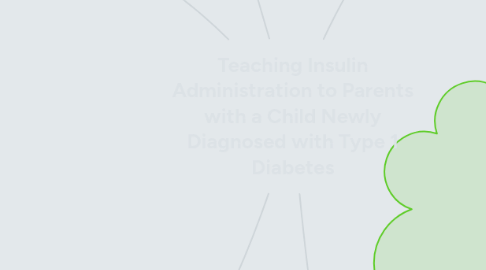
1. Sociocultural Learning Theory
1.1. Vygotsky (1962)
1.1.1. View of Knowledge
1.1.1.1. Social interaction influences learning
1.1.2. View of Leaning
1.1.2.1. Learning is interactive
1.1.2.1.1. Most learning occurs in the zone of proximal development
1.1.3. Role of the Student
1.1.3.1. Observe the teacher modeling the skill or behavior
1.1.3.2. Begin to take on responsibility of performing the skill on their own
1.1.3.3. Ask questions
1.1.3.4. Utilize reflection techniques, be aware of learning style
1.1.4. Role of the Educator
1.1.4.1. Provide support and gradually withdraw coaching as the learner becomes more comfortable
1.1.4.1.1. Recognize the learner's zone of proximal development to best facilitate the process
1.1.4.2. Promote independence
1.1.5. How Theory Informs the Education of Insulin Administration to Parents of Children Newly Diagnosed with Type 1 Diabetes
1.1.5.1. Nurse should create a supportive environment for the parent and model the skill. The nurse can utilize a teach back method assisting the parent as needed and slowly removing the support as the parent further understands and demonstrates the skill accurately.
1.1.5.1.1. Provide feedback as necessary to help the parent feel more comfortable.
2. Behavioral Learning Theory
2.1. Skinner (1953), Mager (1962), Pavlov
2.1.1. View of Knowledge
2.1.1.1. Behavior is learned and can be shaped by rewards
2.1.1.2. Concerned with observable results
2.1.2. View of Leaning
2.1.2.1. All behavior is learned
2.1.2.2. Information should be presented sequentially
2.1.2.3. Use of "reinforcers" to encourage the positive behavior
2.1.2.4. If students are given the right stimulus, they will have the desired response
2.1.3. Role of the Student
2.1.3.1. Motivation to succeed is through tangible rewards
2.1.3.2. Observe skill and practice skill
2.1.4. Role of the Educator
2.1.4.1. Provide structured learning experience
2.1.4.1.1. Present information in a step by step process
2.1.4.1.2. Utilize skills demonstration and simulation
2.1.4.1.3. Set appropriate goals
2.1.4.2. Give learner positive feedback
2.1.4.2.1. Be consistent
2.1.5. How Theory Informs the Education of Insulin Administration to Parents of Children Newly Diagnosed with Type 1 Diabetes
2.1.5.1. Provide positive reinforcement for the parent
2.1.5.2. The nurse provides clear instruction and objectives prior to the start of the teaching session
2.1.5.2.1. Teaches sequentially and provides motivation for the parent
3. Population: Parents of children newly diagnosed with Type 1 Diabetes
3.1. Education should be done in multiple sessions over a few days prior to discharge from the hospital
4. Social Learning Theory
4.1. Bandura (1977)
4.1.1. View of Knowledge
4.1.1.1. If the learner believes they can do well, they will be able to take on tasks with more confidence
4.1.2. View of Leaning
4.1.2.1. Learn through observation
4.1.2.1.1. Component processes of learning: Attention, Retention, Motor Reproduction, and Motivation
4.1.2.2. Affected by mental state
4.1.2.3. Goal is to develop self-efficacy
4.1.3. Role of the Student
4.1.3.1. Observe the nurse
4.1.3.1.1. Model the behavior/skill
4.1.4. Role of the Educator
4.1.4.1. Model the skill
4.1.4.1.1. Encourage the parent and provide clear instructions to perform the skill
4.1.5. How Theory Informs the Education of Insulin Administration to Parents of Children Newly Diagnosed with Type 1 Diabetes
4.1.5.1. Nurse should model how to draw up insulin from a multi-use vial and demonstrate how to inject the insulin.
4.1.5.1.1. Parent should be encouraged and able to focus on what the nurse is doing
4.1.5.1.2. Review insulin syringes, injection sites, how to clean the site and utilize needle safety
5. Adult Learning Theory
5.1. Knowles (1980)
5.1.1. View of Knowledge
5.1.1.1. Andragogy
5.1.1.2. Desire to learn is to problem solve, view the information as important
5.1.2. View of Learning
5.1.2.1. Use past experiences and new knowledge to solve problems
5.1.2.1.1. Process of learning is shaped by past experiences
5.1.2.2. Self directed and internally motivated
5.1.2.2.1. Task and problem centered
5.1.2.3. Learner needs to take responsibility for their learning and decisions
5.1.3. Role of the Student
5.1.3.1. Active involvement in the learning process
5.1.3.2. Take responsibility in the learning process
5.1.3.3. Be involved in the evaluation process
5.1.4. Role of the Educator
5.1.4.1. Create a supportive environment for the learner
5.1.4.1.1. Ensure mutual respect and empowerment
5.1.4.1.2. Provide feedback related to skills
5.1.4.1.3. Provide resources for the learner
5.1.4.1.4. Focus on the process, not the content
5.1.4.1.5. Utilize case studies, role playing, simulation, and self-evaluation
5.1.4.2. Act as a facilitator or resource
5.1.5. How Theory Informs the Education of Insulin Administration to Parents of Children Newly Diagnosed with Type 1 Diabetes
5.1.5.1. Explain the parent the importance of being able to administer insulin to their child
5.1.5.1.1. Order learning activities appropriate to learning readiness
5.1.5.2. Create a supportive environment for the parent, actively engage them in the learning process, model the skill
5.1.5.2.1. Have the parent model the skill and provide feedback as needed
5.1.5.3. The parent will most likely be anxious about learning a new skill affecting their child's health
5.1.5.3.1. It is important to create a relaxed environment, respect the parent's concerns and fears, and empower them.

